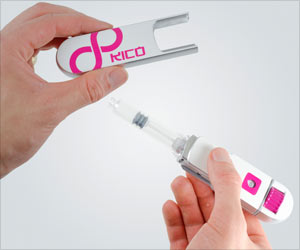Veiseh, an assistant professor of bioengineering, has spent more than a decade developing biomaterials that protect implanted cell therapies from the immune system. Miller, an associate professor of bioengineering, has spent more than 15 years researching techniques to 3D print tissues with vasculature, or networks of blood vessels.
‘The hydrogel material, which has proven effective for encapsulating cell treatments in bead-sized spheres, has pores small enough to keep the cells inside from being attacked by the immune system but large enough to allow passage of nutrients and life-giving insulin.’
“If we really want to recapitulate what the pancreas normally does, we need vasculature,” Veiseh said. “And that’s the purpose of this grant with JDRF. The pancreas naturally has all these blood vessels, and cells are organized in particular ways in the pancreas. Jordan and I want to print in the same orientation that exists in nature.”
Type 1 diabetes is an autoimmune disease that causes the pancreas to stop producing insulin, the hormone that controls blood-sugar levels. About 1.6 million Americans live with Type 1 diabetes, and more than 100 cases are diagnosed each day. Type 1 diabetes can be managed with insulin injections. But balancing insulin intake with eating, exercise and other activities is difficult. Studies estimate that fewer than one-third of Type 1 diabetics in the U.S. consistently achieve target blood glucose levels.
Veiseh’s and Miller’s goal is to show their implants can properly regulate blood glucose levels of diabetic mice for at least six months. To do that, they’ll need to give their engineered beta cells the ability to respond to rapid changes in blood sugar levels.
“We must get implanted cells in close proximity to the bloodstream so beta cells can sense and respond quickly to changes in blood glucose,” Miller said.
Ideally, insulin-producing cells will be no more than 100 microns from a blood vessel, he said.
“We’re using a combination of pre-vascularization through advanced 3D bioprinting and host-mediated vascular remodeling to give each implant several shots at host integration,” Miller said.
The insulin-producing cells will be protected with a hydrogel formulation developed by Veiseh, who is also a Cancer Prevention and Research Institute of Texas Scholar.
“Blood vessels can go inside of them,” Veiseh said of the hydrogel compartments. “At the same time, we have our coating, our small molecules that prevent the body from rejecting the gel. So it should harmonize really well with the body.”
If the implant is too slow to respond to high or low blood sugar levels, the delay can produce a roller coaster-like effect, where insulin levels repeatedly rise and fall to dangerous levels.
“Addressing that delay is a huge problem in this field,” Veiseh said. “When you give the mouse — and ultimately a human — a glucose challenge that mimics eating a meal, how long does it take that information to reach our cells, and how quickly does the insulin come out?”
By incorporating blood vessels in their implant, he and Miller hope to allow their beta-cell tissues to behave in a way that more closely mimics the natural behavior of the pancreas.
Source: Eurekalert



